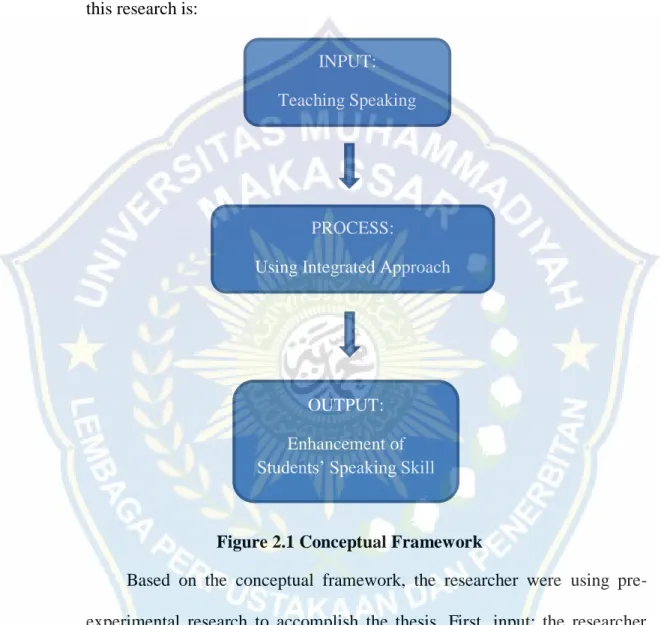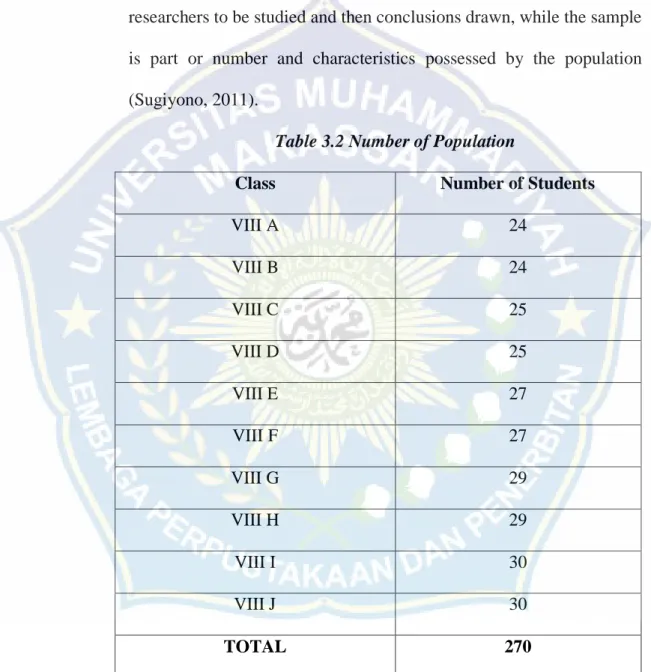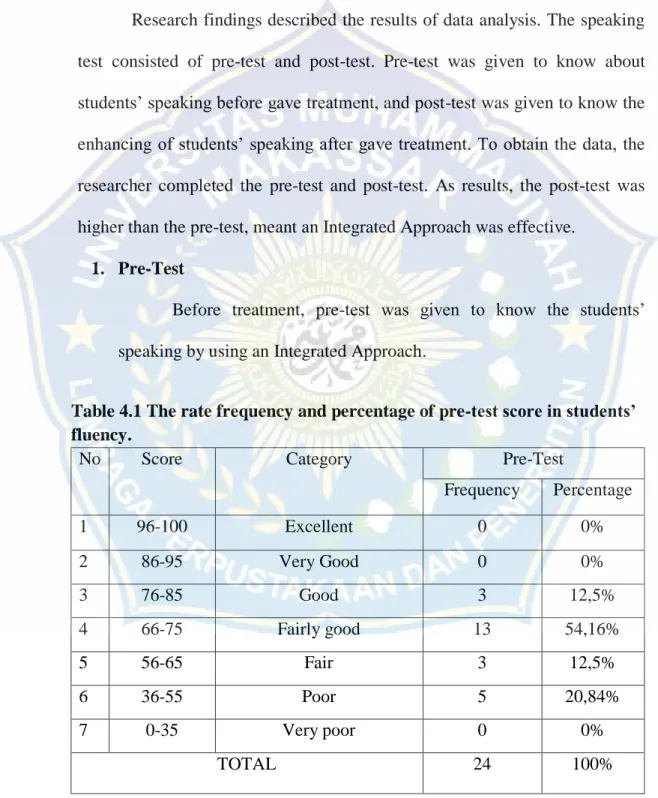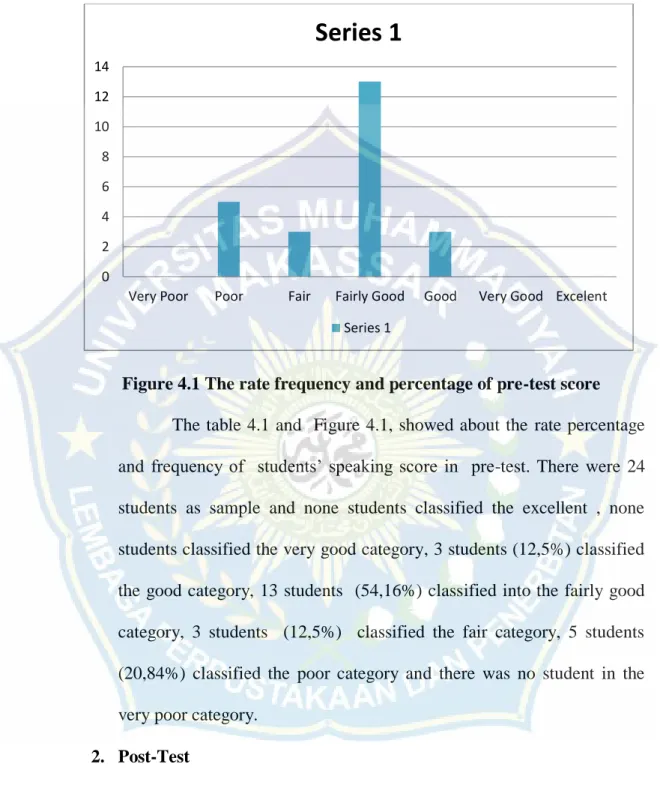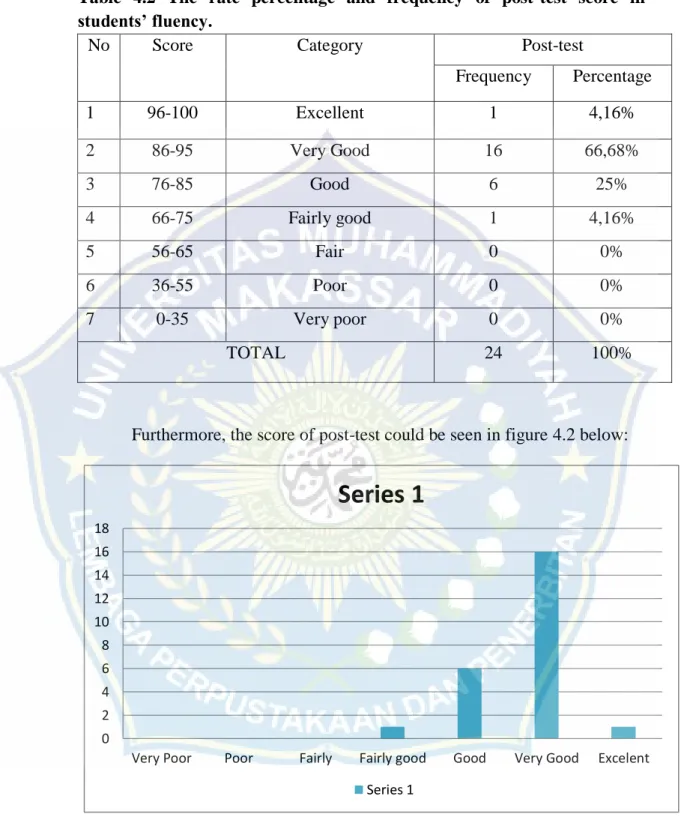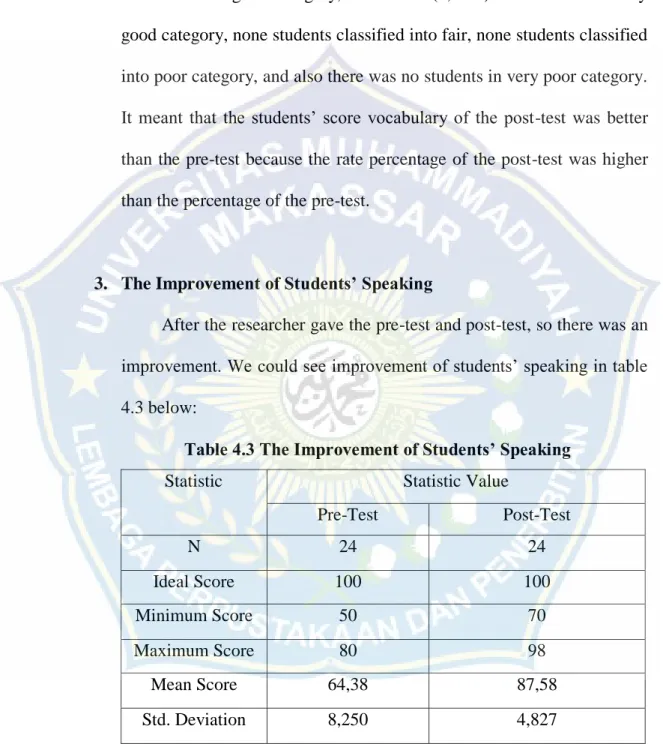The researcher used pre-experimental research which employs one group Pre-test and Post-test. Based on the result of the research, the researcher found that the t-test was higher than the t-table 12.295>2.073. Principal of SMPN 4 Sungguminasa, Sukawati S.Pd., M.Pd, who gave permission to the researcher to do this thesis.
For this reason, the researcher suggests an easier and more effective way for students to deal with these problems. According to the title adopted by the researcher, "Integrated Approach" is a method that can be used to develop students' ability to speak foreign languages. So in this research, the researcher would like to conduct the research under the title "Using Integrated Approach to Enhance Speaking Skills at Second Grade Students' of SMPN 4 Sungguminasa".
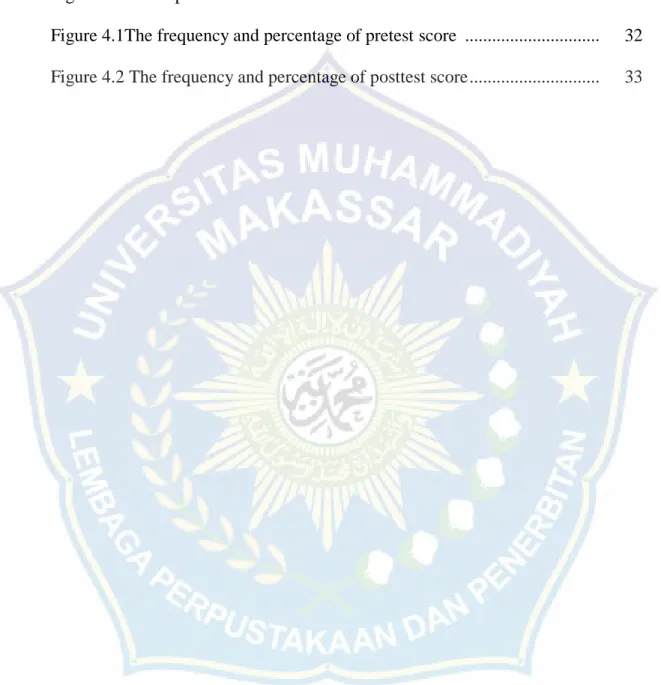
Problem Statement
Objective of the Research
Significance of the Research
For the second grade students of SMPN 4 Sungguminasa, it is expected that this research will give them a way to develop their speaking skill through an integrated approach. For the teachers, the research will be an input to develop their ability in choosing the appropriate technique in the teaching of Speaking.
Scope of the Research
Kalpana (2018), she concluded in her research that the integrated approach can be a tool to improve English speaking skills. At Kalpana, she uses an integrated approach to teaching English speaking skills, focusing on productive skills and receptive skills. In Hidayet, he uses an integrated approach to improve students' language skills by using feature films.
Hoda Divsar and Abdorreza Tahriri used a holistic approach to researching the effectiveness of student literature. While in my research, I used an integrated approach to improve speaking skills focused on vocabulary fluency in the second grade students of SMPN 4 Sungguminas. According to Fogarty (1991), a holistic approach is a learning system that enables students to be active both individually and collectively.
Conceptual Framework
Hypotheses
In this research, the researcher used Pre-experimental Research which uses one group pre-test – post-test. This research will be carried out through three steps of process: pre-test - treatment - post-test to investigate whether the use of an integrated approach to improve students' speaking skills. After conducting treatments with an integrated approach, a post-test will be given to measure students' speaking skills.
The population is a generalization area consisting of: objects/subjects that have certain qualities and characteristics determined by researchers to be studied and then conclusions are drawn, while the sample is a part or number and characteristics that the population possesses (Sugiyono, 2011) . Purposive sampling technique is a sampling technique in which the researcher relies on the judgment of students when selecting members of the population to participate in the study. The researcher chose this class because she believed that each class in a class had different levels of knowledge based on their class rank, so the researcher was sure that the students in this class had a high enthusiasm to learn English, especially in speaking .
Independent variable is a variable that influences or is the change or emergence of a dependent variable, and a dependent variable is a variable that is influenced or caused by a dependent variable (Sugiyono, 2015: 61). The independent variable here was an integrated approach, which was the learning resources that helped the students improve their speaking skills, and the dependent variable was the students' vocabulary.
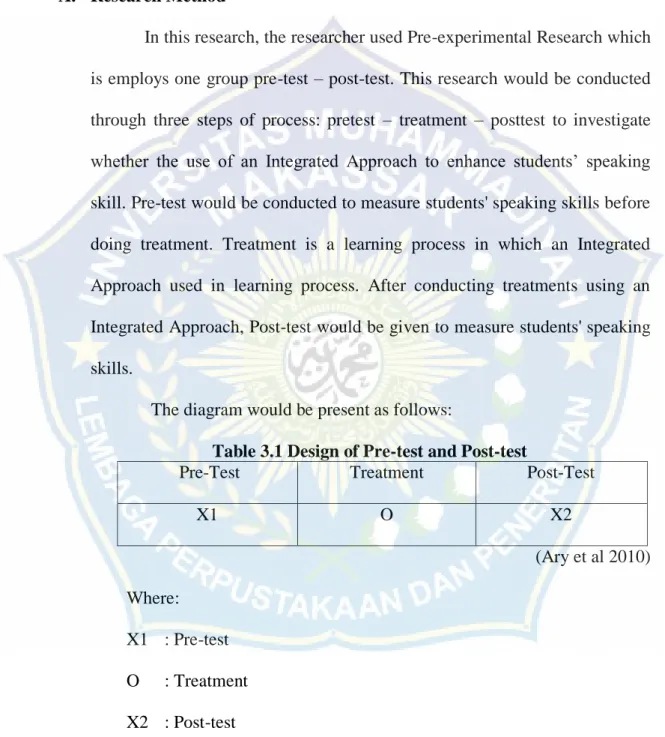
Research Instrument
Technique of Data Collection
After the treatment, the researcher gave the students a post-test in the same form but different sentences with the pre-test to find out their improvement after using the integrated approach in the teaching and learning process. Finally, the scores of all students in both the pre-test and post-test were tabulated and analyzed using a formula. They speak very hastily and multi-sentence inappropriately using vocabulary and little or no communication.
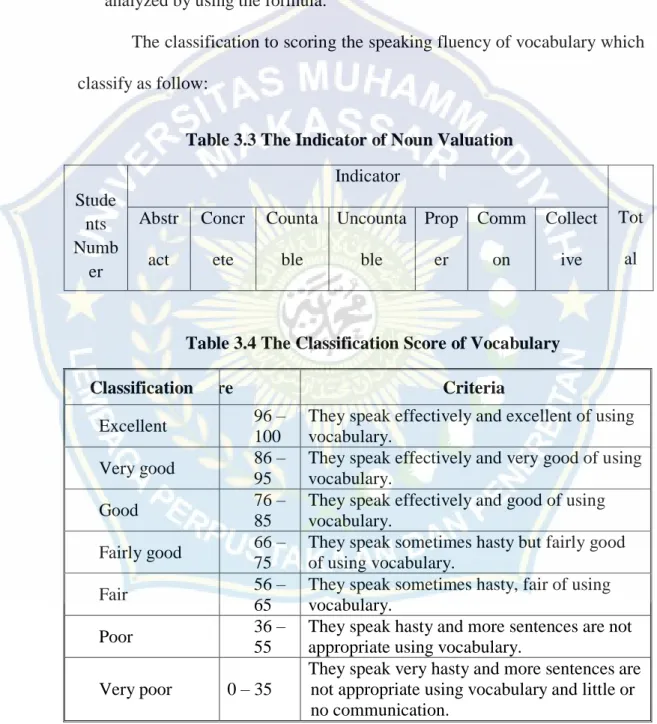
Technique of Data Analysis
- Pre-Test
- Post-Test
- The Improvement of Students’ Speaking
- Hypotheses Testing
Finding the significant difference between the pre-test and the post-test by calculating the t-test value. After obtaining the students significance score (t value) was compared with the t table value. When the t-test value was found to be equal to or greater than the t-table value, it means that the null hypothesis (H0) was rejected and the alternative hypothesis (H1) was accepted because there is significant difference between the pre- test and post-test and after teaching speaking using an integrated approach.
Pre-test was given to know if students' speech before given treatment and post-test was given to know the strengthening of students' speech after given treatment. As results, the post-test was higher than the pre-test, which meant that an integrated approach was effective. There were 24 students as a sample and no students classified the excellent, no students classified the very good category, 3 students (12.5%) classified the good category, 13 students (54.16%) classified the fairly good category, 3 students (12.5%) classified the fair category, 5 students (20.84%) classified the poor category, and there were no students in the very poor category.
It meant that the students' vocabulary scores on the post-test were better than those on the pre-test because the percentage of the post-test was higher than the percentage of the pre-test. After the researcher had administered the pre- and post-test, there was therefore an improvement. Based on the data in Table 4.3 above, it can be seen that the average score of the student in the Pre-Test was 64.37.
While the mean score in the Post-Test was 87.58 with the standard deviation being 4.827, the minimum score obtained by the student was 70 and the maximum score was 98. It was given by the pre-test and the post-test mean score, with the post-test score being higher and had a significant improvement in the pretest mean after given treatment. The table showed that the result was 16,193>2,068, which meant that there was improvement in students' speech before and after given treatment using an integrated approach in the 2nd grade students of SMPN 4 Sungguminasa.
Based on the elaboration above, it could be concluded that the null hypothesis (H0) was rejected, while the alternative.
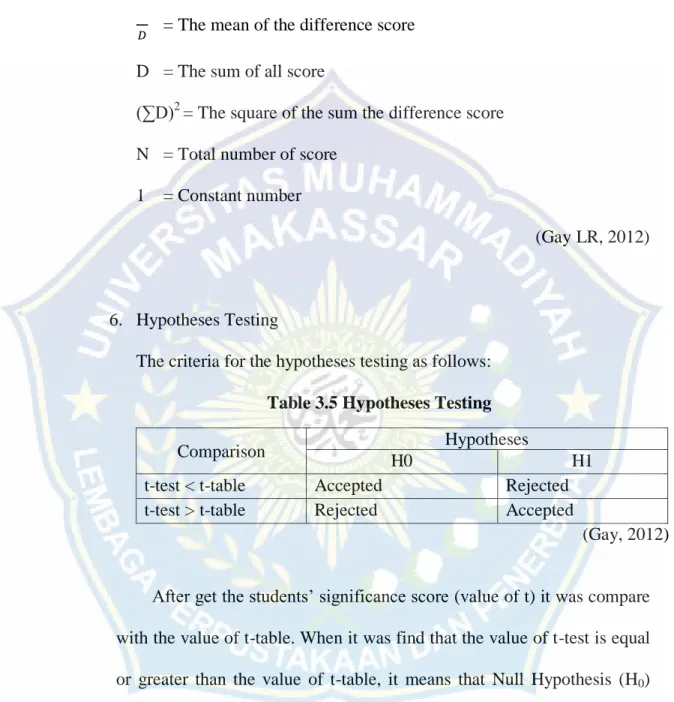
The Discussion
At the end of his research he found that applying the integrated approach can improve students' language skills by looking, listening and speaking. The data were then analyzed using SPSS (Statistical Product and Service Solutions) for Windows version 22.0. The result of this thesis shows that in the first group using the integrated approach the result is 7.279 (t-count is higher than t-table). while the second group without using the integrated approach scored 2.021 (t-count is lower than t-table). So, the Integrated Approach was effective to improve English vocabulary at the tertiary level of Kyrgyz-Turk Manas University.
Additionally, according to Allen (2014), an integrated approach is one in which learners learn by doing in a learner-centered environment in learner interest contexts. The teacher can use themes, stories or projects to build on children's interests and level of understanding. An integrated approach has roots in early childhood education, where a hallmark for quality is the seamless interconnection of developmental domains and content areas.
The relationship of this research with the previous study that this research used the Integrated Approach in learning media and the researcher takes reference from the previous study to be used as a reference and the result of the study shows that the use of the integrated approach in the teaching process and learning. it is effective and can improve students' speaking skills. Based on the findings and discussion, the researcher concluded that the integrated approach method was effective to increase students' speaking ability. Using an integrated approach is effective to increase students' speaking skills in the second grade of SMPN 4 Sungguminasa.
Suggestion
An analysis of the third year students' speaking problem at the English department of Bung Hatta University. A study of secondary school teachers' views on the teaching of integrated social studies in Oyo State Nigeria (Unpublished doctoral dissertation). Empowering spraying ability for EFL students using psychological play technique for the second grade students at SMAN 2 Bulukumba.
APPENDICES
LESSON PLAN
- KOMPETENSI INTI
- KOMPETENSI DASAR
- TUJUAN PEMBELAJARAN
- MATERI PEMBELAJARAN
- METODE PEMBELAJARAN
- LANGKAH-LANGKAH PEMBELAJARAN
- MEDIA, ALAT DAN SUMBER PEMBELAJARAN
Siswa membaca contoh kalimat lain yang menunjukkan orang, benda, dan binatang dalam jumlah yang tidak ditentukan dan menanyakan asal usulnya dari sumber lain. Siswa menyimpulkan hasil analisisnya terhadap fungsi sosial, struktur teks, dan unsur kebahasaan kalimat yang menyatakan dan mempertanyakan keberadaan orang, benda, dan hewan yang jumlahnya tidak terbatas yang telah dipelajarinya. Dengan bimbingan dan arahan guru, siswa membandingkan kalimat yang menyatakan dan menanyakan tentang jumlah dan ciri-ciri orang, benda, dan hewan (fungsi sosial, struktur teks, dan unsur kebahasaan).
Siswa membaca contoh kalimat lain yang menyatakan dan membandingkan jumlah dan sifat orang, benda, dan hewan dalam jumlah yang tidak ditentukan dari sumber lain. Dalam kerja kelompok terbimbing, siswa menganalisis fungsi sosial, makna dan fungsi ungkapan, struktur teks dan unsur kebahasaan, serta format penulisan kalimat yang membuat perbandingan dan menanyakan jumlah dan sifat orang, benda, dan hewan dalam jumlah yang tidak ditentukan. . Siswa menyimpulkan hasil analisis fungsi sosial, struktur teks, dan unsur kebahasaan kalimat yang membuat perbandingan dan bertanya tentang jumlah dan ciri-ciri orang, benda, dan hewan dalam jumlah tidak terbatas yang telah dipelajarinya.
Siswa menunjukkan dan bertanya secara tertulis dan lisan tentang perbedaan jumlah dan sifat manusia, benda dan hewan dalam jumlah yang tidak ditentukan), dalam bahasa Inggris, di depan kelas. Materi Pokok: Teks lisan dan tulis yang menunjukkan dan meminta perbandingan jumlah dan ciri-ciri manusia, hewan, dan benda. Siswa mendengarkan/membaca beberapa contoh menyatakan dan membuat perbandingan jumlah dan ciri-ciri orang, hewan, dan benda.
Siswa mengikuti kalimat yang menyatakan dan mengajukan pertanyaan yang membandingkan jumlah dan ciri-ciri orang, hewan, dan benda. Dengan bimbingan dan bimbingan guru, siswa bertanya tentang perbedaan keadaan dan meminta perbandingan jumlah dan sifat manusia, hewan dan benda. Siswa membaca contoh situasi dan menanyakan perbandingan jumlah dan sifat manusia, hewan, dan benda dari berbagai sumber lain.
Siswa menyimpulkan hasil analisis fungsi sosial, struktur teks, dan unsur kebahasaan dengan menyatakan dan bertanya tentang perbandingan jumlah dan ciri-ciri orang, hewan, dan benda.
ATTENDENCE LIST
THE STUDENTS’ SCORE IN PRE-TEST
PRE – TEST
STUDENTS’ TREATMENT
Find as many objects as possible and describe them according to their color and location.
THE STUDENTS’ SCORE IN POST-TEST
POST – TEST
FINDINGS IN CHAPTER IV
DOCUMENTATION
